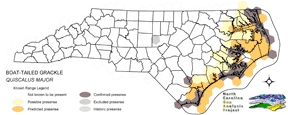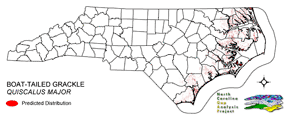
| Taxa: |
| Order: |
| Family: |
| Aves |
| Passeriformes |
| Icteridae |
| NatureServe Global Rank: |
| NatureServe State (NC) Rank: |
| G5 |
| S5B,S5N |
| Federal Status: |
| NC State Status: |
| --- |
| --- |


| Land Unit |
| US Fish & Wildlife Service |
| US Forest Service |
| US National Park Service |
| US Department of Defense |
| NC State Parks |
| NC University System |
| NC Wildlife Res. Com. |
| NC Forest Service |
| NC Div. of Coastal Mgmt. |
| Local Governments |
| Non-Governmental Org. |
| Other Public Lands |
| Private Lands |
| GAP Status 1-2 |
| All Protected Lands |
| Statewide |
| Hectares |
| 21,171.78 |
| 605.79 |
| 12,314.88 |
| 10,318.68 |
| 1,773.63 |
| 241.11 |
| 4,717.08 |
| 12.96 |
| 1,740.51 |
| 34.11 |
| 2,107.26 |
| 94.77 |
| 214,251.84 |
| 36,106.02 |
| 54,479.88 |
| 269,384.40 |
| Acres |
| 52,316.60 |
| 1,496.94 |
| 30,430.73 |
| 25,498.01 |
| 4,382.73 |
| 595.80 |
| 11,656.16 |
| 32.02 |
| 4,300.89 |
| 84.29 |
| 5,207.15 |
| 234.18 |
| 529,427.72 |
| 89,219.90 |
| 134,622.69 |
| 665,663.22 |
| % of Dist. on |
| Prot. Lands |
| 38.9 % |
| 1.1 % |
| 21.5 % |
| 18.9 % |
| 3.3 % |
| 0.4 % |
| 8.7 % |
| < 0.1 % |
| 3.2 % |
| 3.9 % |
| 3.9 % |
| < 0.1 % |
| < 0.1 % |
| 66.3 % |
| ----- |
| ----- |
| % of Dist. on |
| All Lands |
| 7.9 % |
| 0.2 % |
| 4.6 % |
| 3.8 % |
| 0.7 % |
| < 0.1 % |
| 1.8 % |
| < 0.1 % |
| 0.6 % |
| < 0.1 % |
| 0.8 % |
| < 0.1 % |
| 79.5 % |
| 13.4 % |
| ----- |
| ----- |
|
Common on the barrier islands and the adjacent mainland, but less common along the western shores of the Pamlico Sound (Fussell 1994). Breeds in large colonies of up to one hundred pairs (Skutch 1996). Locally prefers salt or brackish marshes (Potter et al. 1980), but will also inhabit fresh water marshes (Skutch 1996), pastures and cultivated fields in other parts of the species' range (Ehrlich et al. 1988). Forages on the ground and by wading in shallow water; also pirates food from Glossy Ibis and probably herons (Ehrlich et al. 1988). NATURE SERVE GLOBAL HABITAT COMMENTS: Coastal salt marshes and barrier and sea islands, around ponds and streams (FL peninsula), farmland, towns and cities. BREEDING: Nests generally near or over water, in willows, cattails, sawgrass, bulrushes; also up to 25 m in trees. See Dunham (1990) for information on nest-site selection in Florida. |
| Code | Name | Description | NC Natural Heritage Program Equivalent |
| 3 | Tidal Marsh | Fresh and brackish tidal marshes, including cord grass, wild rice, sawgrass and needlerush alliances. | Brackish Marsh, Interdune pond, Maritime wet grassland |
| 124 | Maritime Scrubs and Tidal Shrublands | Coastal shrubs including wax-myrtle, swamp rose, alder, yaupon, and greenbriar. | Maritime Shrubs, Salt Shrub |
| 375 | Hypersaline coastal salt flats | Tidal flats within salt marshes, including saltmeadow cordgrass or sea-purslane dominated alliances. | Salt Marsh |
| 372 | Interdune Herbaceous Wetlands | Dune swales with permanently flooded to intermittently exposed hydrology. Species composition depends on salinity and can include cut grass, spike-rush, mosquito fern, and hornwort. | Interdune Pond, Maritime Wet Grasslands |
| 371 | Maritime Grasslands | Dune grass community consisting of sea oats and beach grasses. | Dune grass, Maritime dry grassland |
| 126 | Interdune Wooded Depression Swamp | Includes swamps dominated by sweetbay and swampbay or dogwood dominated forests. | Maritime Shrub Swamp, Maritime Swamp Forest |
| 380 | Coastal Plain Fresh Water Emergent | Emergent vegetation in fresh water seepage bogs, ponds and riverbeds of the coastal plain. Includes alliances dominated by sedges, eelgrass, as well as cane found in unforested cane-brakes. | Small Depression Pond, Sandhill Seep, Floodplain Pool, Unforested Floodplain Canebrake, Riverscour Prairies, Vernal Pools |
| 173 | Coastal Plain Riverbank Shrubs | Shrub dominated riverbanks, commonly dominated by willows and/or alders. | Sand and Mud Bar |
| 205 | Agricultural Pasture/Hay and Natural Herbaceous | Farm fields used for pasture grass or hay production, as well as old fields dominated by native and exotic grasses. | No equivalent |
| 202 | Residential Urban | Includes vegetation interspersed in residential areas. Includes lawns, mixed species woodlots, and horticultural shrubs. Vegetation accounts for between 20 - 70% of the cover. | No equivalent |
|
Bjorklund, M. 1991. Evolution, phylogeny, sexual dimorphism and mating system in the grackles (QUISCALUS spp.:Icterinae). Evolution 45:608-621.
Fussell, J.O. III. 1994. A birderís guide to coastal North Carolina. Chapel Hill and London: The University of North Carolina Press. Bent, A.C. 1958. Life histories of North American blackbirds, orioles, tanagers, and their allies. U.S. National Museum Bulletin 211. Washington, DC. Dunham, M. L. 1990. Nest-site selection by boat-tailed grackles. Wilson Bull. 102:702-706. Harrison, C. 1978. A field guide to the nests, eggs and nestlings of North American birds. Collins, Cleveland, Ohio. Harrison, H.H. 1979. A field guide to western birds' nests. Houghton Mifflin Company, Boston. 279 pp. Terres, J.K. 1980. The Audubon Society encyclopedia of North American birds. Alfred A. Knopf, New York. Bancroft, G. T. 1986. Nesting success and mortality of theboat-tailed grackle. Auk 103:86-99. American Ornithologists' Union (AOU), Committee on Classification and Nomenclature. 1983. Check-list of North American Birds. Sixth Edition. American Ornithologists' Union, Allen Press, Inc., Lawrence, Kansas. Ehrlich, P.R., D.S. Dobkin, and D. Wheye. 1988. The birder's handbook:a field guide to the natural history of North American birds. Simon and Shuster, Inc., New York. xxx + 785 pp. Avise, J.C., and R.M. Zink. 1988. Molecular genetic divergence between avian sibling species:king and clapper rails, long-billed and short-billed dowitchers, boat-tailed and great-tailed grackles, and tufted and black-crested titmice. Auk 105:516-528. Zink, R.M., W.L. Rootes, and D.L. Dittman. 1991. Mitochondrial DNA variation, population structure, and evolution of the common grackle (QUISCALUS QUISCALA). Condor 93:318-329. |
For more information please contact them at:
NC-GAP Analysis Project
Dept. of Zoology, NCSU
Campus Box 7617
Raleigh, NC 27695-7617
(919) 513-2853
www.basic.ncsu.edu/ncgap